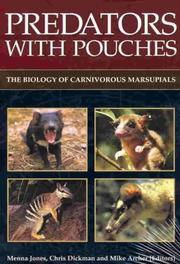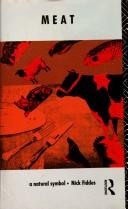| Listing 1 - 7 of 7 |
Sort by
|
Book
Year: 1907 Publisher: Paris : Schleicher,
Abstract | Keywords | Export | Availability | Bookmark
 Loading...
Loading...Choose an application
- Reference Manager
- EndNote
- RefWorks (Direct export to RefWorks)
Book
Year: 2018 Publisher: Fort Collins, CO : U.S. Department of Agriculture, Forest Service, Rocky Mountain Research Station,
Abstract | Keywords | Export | Availability | Bookmark
 Loading...
Loading...Choose an application
- Reference Manager
- EndNote
- RefWorks (Direct export to RefWorks)
Forest animals --- Carnivorous animals --- Endangered species --- Monitoring
Book
ISBN: 1486305156 9781486305155 9781486305162 1486305164 9781486305148 1486305148 Year: 2018 Publisher: Clayton South, VIC
Abstract | Keywords | Export | Availability | Bookmark
 Loading...
Loading...Choose an application
- Reference Manager
- EndNote
- RefWorks (Direct export to RefWorks)
Most living carnivorous marsupials lead a secretive and solitary existence. From tiny insect eaters to the formidable Tasmanian Devil, Secret Lives of Carnivorous Marsupials offers rare insight into the history and habits of these creatures - from their discovery by intrepid explorers and scientists to their unique life cycles and incredible ways of hunting prey.Secret Lives of Carnivorous Marsupials provides a guide to the world's 136 living species of carnivorous marsupials and is packed with never-before-seen photos. Biogeography, relationships and conservation are also covered in detail. Readers are taken on a journey through remote Australia, the Americas and dark, mysterious New Guinea - some of the last truly wild places on Earth. The book describes frenzied mating sessions, minuscule mammals that catch prey far larger than themselves, and extinct predators including marsupial lions, wolves and even sabre-toothed kangaroos.
Carnivorous marsupials. --- Carnivores, Marsupial --- Marsupial carnivores --- Marsupicarnivores --- Carnivorous animals --- Marsupials --- Marsupiaux.
Book
ISBN: 0300227590 9780300227598 9780300218152 030021815X Year: 2017 Publisher: New Haven London
Abstract | Keywords | Export | Availability | Bookmark
 Loading...
Loading...Choose an application
- Reference Manager
- EndNote
- RefWorks (Direct export to RefWorks)
Myth and media typically cast animals we consider predators or carnivores as unthinking killers-dangerous, unpredictable, and devoid of emotion. But is this portrait valid? By exploring their inner lives, this pioneering book refutes the many misperceptions that hide the true nature of these animals. We discover that great white sharks express tender maternal feelings, rattlesnakes make friends, orcas abide by an ancient moral code, and much more. Using the combined lenses of natural history, neuroscience, and psychology, G. A. Bradshaw describes how predators share the rainbow of emotions that humans experience, including psychological trauma. Renowned for leading research on post-traumatic stress disorder (PTSD) in elephants and other species, Bradshaw decries the irrational thinking behind wildlife policies that equate killing carnivores with "conservation." In its place, she proposes a new, ethical approach to coexistence with the planet's fiercest animals.
Carnivorous animals. --- Carnivores --- Flesh-eating animals --- Meat-eaters (Animals) --- Meat-eating animals --- Animals

ISBN: 1283154072 9786613154071 0643069860 9780643069862 9781283154079 0643066349 9780643066342 6613154075 9780643099487 0643099484 Year: 2003 Publisher: Collingwood, Vic. : CSIRO Pub.,
Abstract | Keywords | Export | Availability | Bookmark
 Loading...
Loading...Choose an application
- Reference Manager
- EndNote
- RefWorks (Direct export to RefWorks)
A comprehensive reference to the biology of carnivorous marsupials.
Carnivorous marsupials --- Carnivorous animals --- Carnivores --- Flesh-eating animals --- Meat-eaters (Animals) --- Meat-eating animals --- Animals --- Carnivores, Marsupial --- Marsupial carnivores --- Marsupicarnivores --- Marsupials
Book
ISBN: 161091208X 159726461X 1597269824 1597269832 Year: 2014 Publisher: Washington, DC : Island Press/Center for Resource Economics : Imprint: Island Press,
Abstract | Keywords | Export | Availability | Bookmark
 Loading...
Loading...Choose an application
- Reference Manager
- EndNote
- RefWorks (Direct export to RefWorks)
What would it be like to live in a world with no predators roaming our landscapes? Would their elimination, which humans have sought with ever greater urgency in recent times, bring about a pastoral, peaceful human civilization? Or in fact is their existence critical to our own, and do we need to be doing more to assure their health and the health of the landscapes they need to thrive? In The Carnivore Way, Cristina Eisenberg argues compellingly for the necessity of top predators in large, undisturbed landscapes, and how a continental-long corridor—a “carnivore way”—provides the room they need to roam and connected landscapes that allow them to disperse. Eisenberg follows the footsteps of six large carnivores—wolves, grizzly bears, lynx, jaguars, wolverines, and cougars—on a 7,500-mile wildlife corridor from Alaska to Mexico along the Rocky Mountains. Backed by robust science, she shows how their well-being is a critical factor in sustaining healthy landscapes and how it is possible for humans and large carnivores to coexist peacefully and even to thrive. University students in natural resource science programs, resource managers, conservation organizations, and anyone curious about carnivore ecology and management in a changing world will find a thoughtful guide to large carnivore conservation that dispels long-held myths about their ecology and contributions to healthy, resilient landscapes.
Predatory animals --- Wildlife conservation --- Carnivorous animals --- Carnivores --- Flesh-eating animals --- Meat-eaters (Animals) --- Meat-eating animals --- Animals --- Predaceous animals --- Predacious animals --- Predators --- Nature Conservation. --- Animal ecology. --- Endangered ecosystems. --- Biodiversity. --- Animal Ecology. --- Ecosystems. --- Biological diversification --- Biological diversity --- Biotic diversity --- Diversification, Biological --- Diversity, Biological --- Biology --- Biocomplexity --- Ecological heterogeneity --- Numbers of species --- Threatened ecosystems --- Biotic communities --- Nature conservation --- Zoology --- Ecology --- Conservation of nature --- Nature --- Nature protection --- Protection of nature --- Conservation of natural resources --- Applied ecology --- Conservation biology --- Endangered ecosystems --- Natural areas --- Conservation --- Nature conservation. --- Biocenoses --- Biocoenoses --- Biogeoecology --- Biological communities --- Biomes --- Biotic community ecology --- Communities, Biotic --- Community ecology, Biotic --- Ecological communities --- Ecosystems --- Natural communities --- Population biology

ISBN: 0415048370 Year: 1991 Publisher: London New York Routledge
Abstract | Keywords | Export | Availability | Bookmark
 Loading...
Loading...Choose an application
- Reference Manager
- EndNote
- RefWorks (Direct export to RefWorks)
Alimentation -- Anthropologie --- Alimentation -- Coutumes --- Animaux carnivores --- Anthropologie de l'alimentation --- Carnivora --- Carnivoren --- Carnivores --- Carnivorous animals --- Coutumes alimentaires --- Eating --- Eetgedrag --- Eetgewoonten --- Fissipèdes --- Food customs --- Food habits --- Food preferences --- Foodways --- Gewoonten [Voedings] --- Habitudes alimentaires --- Human beings--Food habits --- Meat --- Meat consumption --- Meat industry and trade --- Meat-eating animals --- Packing industry --- Pratiques alimentaires --- Préférences alimentaires --- Viande --- Viande--Industrie et commerce --- Vlees --- Vlees--Industrie en handel --- Vleesindustrie en vleeshandel --- Voedingsgewoonten --- Voedsel -- Voorkeuren --- Carnivora. --- Food habits. --- Food preferences. --- Food --- Meat industry and trade. --- Meat. --- Symbolic aspects. --- Symbolic aspects --- Food - Symbolic aspects.
| Listing 1 - 7 of 7 |
Sort by
|

 Search
Search Feedback
Feedback About UniCat
About UniCat  Help
Help News
News